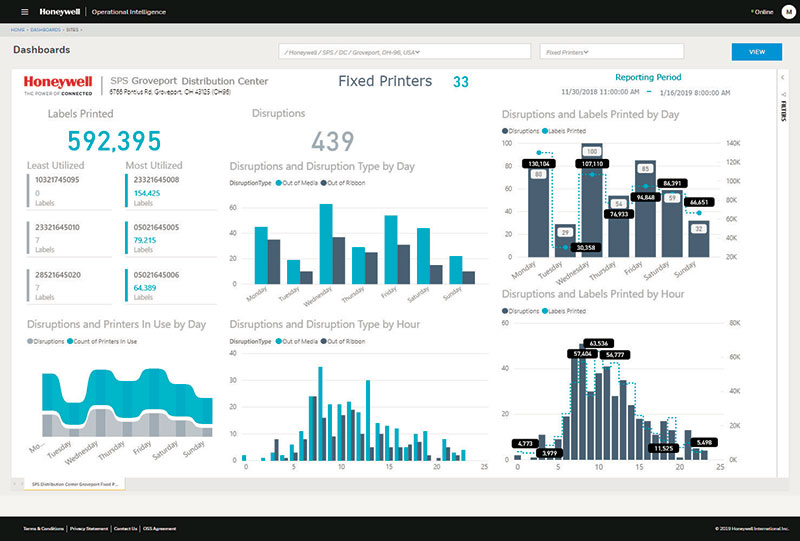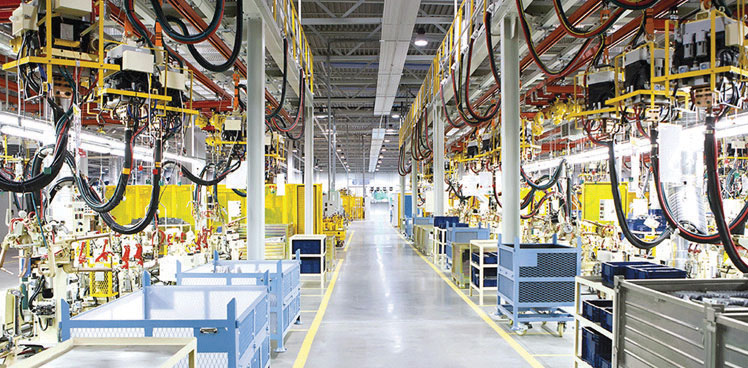Automatic Data Capture (ADC) at the edge
Automatic data capture just got a new ally: the edge. The technology allows everything from scanners to voice systems to process data on the edge of where it is collected. The result is real-time decisions that deal with reality, not a plan that no longer applies.

It’s got to be here somewhere. Stop for just a minute. Let’s look around. It shouldn’t be that difficult to find the edge in materials handling operations. But then again, maybe it is.
What exactly is the edge? Where is it? Why does it matter? These are all good questions, especially if someone has told you only IT needs to know or care about edge. They’re wrong. And just for the record, we’re not talking Microsoft Edge on your laptop.
What we are talking about is data collection with automatic data capture (ADC) hardware from scanners to mobile terminals and voice systems as well as a proliferation of sensors that track everything from vibrations to temperatures in the plant and warehouse. Processing all of this data is becoming edge enabled, and the momentum for bringing edge into day-to-day operations is building.
Two years ago, edge wasn’t much of a consideration. But that’s changed lately.
Capturing data gets done at key decision-making points in your operations. These new edge capabilities allow the data capture hardware to either make or strongly influence operational decisions at that point, without communicating with the Cloud.
“General data capture in DCs is not much different than it was 20 years ago,” says Dan Gilmore, chief marketing officer at Softeon. “But we’re moving to an era of not just capturing and validating distribution center transactions, but to leveraging the technology and data captured to identify dwell times and delays, and provide a data platform for making distribution decisions faster.” There’s no operations manager who wouldn’t see that as significant and helpful.
The data processed by edge is no different than what’s always been collected. But “edge gives you the capability to do data analytics automatically right there on the spot,” says Joe Blazick, manager of data science at Lucas. That data analytics, he continues, is done in an instant, maybe with a little artificial intelligence thrown in. It might allow a conveyor, for instance, to make a routing decision right then, rather than a little later.

“In a nutshell, edge allows more informed decisions to be made closest to where the source data is captured and the activity occurs,” explains Scott Deutsch, president of Americas at Ehrhardt Partner Group (EPG).
“Edge is all about being as real time as possible,” says Hilmer Rivera, global general manager of software at Honeywell. And that is the true power of edge in any industrial or commercial operation.
“People need actionable data to make decisions as close to real time as possible. Edge delivers three highly desired attributes in any operation today: higher productivity, lower cost and an enhanced experience,” adds Rivera.
Those real-time actions help expedite decisions that speed inventory flow in a time of hyper expectations for speed and responsiveness. Put it that way, and it’s not a stretch to think of edge as table stakes for operations for now and the future.
That’s why both operations managers and IT people need to be up on edge. Think of edge management this way: IT does the plumbing while operations focuses on the results.
As Rivera says, “if a doctor prescribes without a diagnosis first, that’s called malpractice. Edge enables the diagnosis first whether it’s a matter of moving a box or knowing that a medical package has exceeded its acceptable temperature parameters.”
The value of edge
By now, you’re probably wondering if edge is part of your ADC system, but you just don’t know for sure. That could well be the case. And it doesn’t entirely matter.
Experts interviewed for this story generally agreed that operations managers don’t have to get too deep into the weeds on edge capabilities. As one said, “we’ll include it in the equipment and software and that should be enough for most.” Think of edge as a stealth player.
Part of that stealthiness is because we are in the early days of edge for ADC hardware. The general consensus is that we are in the build-out stage for incorporating edge capabilities. Companies contacted for this story mentioned edge capabilities in bar code printers, voice systems, RFID readers, warehouse control systems and autonomous mobile robots.

Rivera says a Honeywell survey shows that 80% of industrial companies have a plan to adopt edge in the next 12 months. And they have big expectations. “Companies want edge-enabled solutions to be simple to use, intuitive and highly configurable. Operations managers shouldn’t have to think about this,” adds Rivera.
Sean Elliott, chief technology officer at Körber, puts it all fairly simply. “Edge is all about putting smarts into equipment and software,” he says.
Elliott uses voice as his “for instance” of the value that edge brings to the DC. As most operations managers know all too well, Wi-Fi connectivity in a DC is often spotty at best. That makes it challenging from a voice system to collect data, share it with the Cloud, and get a return instruction without maddening delays.
“However, adding artificial intelligence into a ruggedized device allows the entire transaction to be on the local hardware without a connection to the Cloud. Sometimes it might save 100 milliseconds, other times it might be several seconds,” Elliott says. Both are a gain for operations managers.
That’s the down on the floor explanation of how edge practically works. But there’s something else going on here, too, adds Mark Wheeler, director of supply chain solutions at Zebra. “We are moving from a very deterministic world to a probabilistic world in industrial operations. And that has implications.”
Wheeler explains that our deterministic world is broken down into discrete steps, rules and processes. For instance, a scan in receiving initiates a predefined event that’s an engineered process that is near 100% appropriate every time.
Wheeler says a probabilistic world is not nearly as well defined. It relies on sensors to collect data that confirms this is the right item and in the right quantity. Or the sensors may also indicate that two items are probably missing. That leads to a series of decisions in real time that accommodate the discrepancies.
“A deterministic world relies on manually verified processes and steps while a probabilistic world senses the physical world directly in a variety of ways and may make determinations based on likelihoods,” Wheeler adds. “We are rapidly moving from one to the other with the help of edge.”
Wheeler then brought in what might be the most unexpected player in ADC edge hardware—autonomous mobile robots (AMRs). It starts with tagging inventory and assets with RFID. “By mounting a tag reader on an AMR, that robot can perform continuous cycle counting and provide powerful data visualization to locate misplaced inventory,” says Wheeler. This is probably best described as a bridge between the deterministic and probabilistic worlds.
An inherent strength of edge is transparency. How many times has a conveyor motor just quit? Too many. But with a vibration sensor with edge capability, that potential failure is detected before it happens, explains Alexandro Rezakhani, market product manager for SICK’s Industrial Integration Space.
“What we’re doing here is collecting data over time and analyzing patterns,” he adds. “Edge data is predictive. And there isn’t an ops manager out there who wouldn’t like to know a motor might fail before it does.”
What drives edge
Talk to the experts long enough and the Internet of Things, machine learning, artificial intelligence, Big data and Data analytics all appear to be wrapped up in edge in some way.
Unraveling that advanced technology web is way beyond this article. However, it is worth knowing that edge is proving to be a hot spot for some of the brightest technology advances.
Gilmore of Softeon talks about edge progression. He says that edge allows companies to leverage data already being collected and make use of it before trying to collect more. Gilmore explains it simply starts with data capture, moves to data analytics and then applies it to process improvement. That’s a powerful progression.
Perhaps just as important, edge does not make it possible to use data to make bad decisions in a more sophisticated manner. Instead, it takes real-time data and uses it instantaneously.
All of this happens without formalizing new insights, explains Blazick of Lucas. When edge initiates an action or decision, it isn’t memorialized as a new process, even if it is one.
Edge lives in the moment and is a point in time that requires attention and receives it before edge moves on to the next circumstance. And as Blazick, the data scientist, points out, you don’t need data scientists on staff to make edge work

Article Topics
Magazine Archive News & Resources
Latest in Materials Handling
Geek+ and System Teknik deploy PopPick solution for pharmacy group Med24.dk Beckhoff USA opens new office in Austin, Texas Manhattan Associates selects TeamViewer as partner for warehouse vision picking ASME Foundation wins grant for technical workforce development The (Not So) Secret Weapons: How Key Cabinets and Asset Management Lockers Are Changing Supply Chain Operations MODEX C-Suite Interview with Harold Vanasse: The perfect blend of automation and sustainability Consultant and industry leader John M. Hill passes on at age 86 More Materials HandlingAbout the Author
Subscribe to Materials Handling Magazine

Find out what the world's most innovative companies are doing to improve productivity in their plants and distribution centers.
Start your FREE subscription today.
April 2024 Modern Materials Handling

Latest Resources










